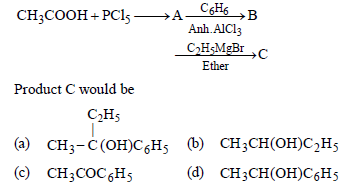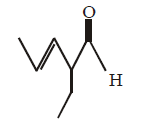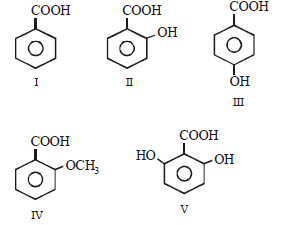VBQs Aldehydes Ketones and Carboxylic Acids Class 12 Chemistry with Aldehydes Ketones and Carboxylic Acids has been provided below for standard students. We have provided chapter wise VBQ for Class 12 Chemistry with Aldehydes Ketones and Carboxylic Acids. The following Aldehydes Ketones and Carboxylic Acids Class 12 Chemistry value based questions with answers will come in your exams. Students should understand the concepts and learn the solved cased based VBQs provided below. This will help you to get better marks in class 12 examinations.
Aldehydes Ketones and Carboxylic Acids VBQs Class 12 Chemistry
Question. Less reactivity of ketone is due to
(a) + I inductive effect decrease positive charge on carbonyl carbon atom
(b) steric effect of two bulky alkyl groups
(c) sp2 hybridised carbon atom of carbonyl carbon atom
(d) Both (a) and (b)
Answer
D
Question. Which one of the following can be oxidised to the corresponding carbonyl compound?
(a) 2-hydroxy-propane
(b) Ortho-nitrophenol
(c) Phenol
(d) 2-methyl-2 hydroxy-propane
Answer
A
Question. Which one of the following on oxidation gives a ketone ?
(a) Primary alcohol
(b) Secondary alcohol
(c) Tertiary alcohol
(d) All of these
Answer
B
Question. Carbonyl compounds undergo nucleophilic addition because of
(a) electronegativity difference of carbon and oxygen atoms
(b) electromeric effect
(c) more stable anion with negative charge on oxygen atom and less stable carbonium ion
(d) None of the above
Answer
B
Question. Clemmensen reduction of a ketone is carried out in the presence of which of the following ?
(a) Glycol with KOH
(b) Zn-Hg with HCl
(c) LiAlH4
(d) H2 and Pt as catalyst
Answer
B
Question. If formaldehyde and KOH are heated, then we get
(a) methane
(b) methyl alcohol
(c) ethyl formate
(d) acetylene
Answer
B
Question. Benzaldehyde reacts with ethanoic KCN to give
(a) C6H5CHOHCN
(b) C6H5CHOHCOC6H5
(c) C6H5CHOHCOOH
(d) C6H5CHOHCHOHC6H5
Answer
B
Question. The reagent which can be used to distinguish acetophenone from benzophenone is
(a) 2,4- dinitrophenylhydrazine
(b) aqueous solution of NaHSO3
(c) benedict reagent
(d) I2and Na2CO3
Answer
D
Question. Choose the correct IUPAC name for

(a) Butan – 2- aldehyde
(b) 2- methylbutanal
(c) 3- methylisobutyraldehyde
(d) 2- ethylpropanal
Answer
B
Question. The IUPAC name of the compound having the molecular formula Cl3C –CH2CHO is
(a) 3, 3, 3- trichloropropanal
(b) 1, 1, 1- trichloropropanal
(c) 2, 2, 2- trichloropropanal
(d) Chloral
Answer
A
Question. Acetaldehyde reacts with semicarbazide and forms semicarbazone. Its structure is

Answer
B
Question.

The above reaction is
(a) Mendius reaction
(b) Sandorn’s reaction
(c) Rosenmund’s reaction
(d) Stephen’s reaction
Answer
D
Question. Phenylmethyl ketone can be converted into ethylbenzene in one step by which of the following reagents?
(a) LiAlH4
(b) Zn-Hg/HCl
(c) NaBH4
(d) CH3MgI
Answer
B
Question. What is formed when a primary alcohol undergoes catalytic dehydrogenation ?
(a) Aldehyde
(b) Ketone
(c) Alkene
(d) Acid
Answer
A
Question. Aldol condensation would not occur in :
(a) CH3COCH3
(b) CH3CH2CHO
(c) HCHO
(d) CH3CHO
Answer
C
Question. The catalyst used in Rosenmund’s reduction is
(a) HgSO4
(b) Pd/BaSO4
(c) anhydrous AlCl3
(d) anhydrous ZnCl2
Answer
B
Question. Which of the following is used to prepare ketone from acyl chloride ?
(a) R-MgX
(b) R2Cd
(c) CO + HCl
(d) CrO3
Answer
B
Question. Aldehydes and ketones are distinguished by which of the following test ?
(a) Lucas test
(b) Tollen’s test
(c) KMnO4 solution (Baeyer’s test)
(d) None of these
Answer
B
Question. The oxidation of toluene to benzaldehyde by chromyl chloride is called
(a) Rosenmund reaction
(b) Wurtz reaction
(c) Etard reaction
(d) Fittig reaction
Answer
C
Question. A compound does not react with 2, 4-dinitrophenylhydrazine, the compound is :
(a) Acetone
(b) Acetaldehdye
(c) CH3OH
(d) CH3CH2COCH3
Answer
C
Question. Propanal and propanone, both have same molecular formula(C3H6O), what do you expect about their boiling points?
(a) Both have same boiling point
(b) Boiling point of propanal is higher than the boiling point of propanone.
(c) Boiling point of propanal is lower than the boiling point of propanone
(d) Nothing can be predicted
Answer
C
Question. The most appropriate reagent to distinguish between acetaldehyde and formaldehyde is :
(a) Fehling’s solution
(b) Tollen’s reagent
(c) Schiff’s reagent
(d) Iodine in presence of base
Answer
D
Question. Which of the following contain an aldehyde?
(a) Vanilla beans
(b) Meadow sweet
(c) Cinnamon
(d) All of these
Answer
D
Question. 2-pentanone and 3-pentanone can be distinguished by :
(a) Cannizaro’s reaction
(b) Aldol condensation
(c) Iodoform reaction
(d) Clemmensen’s reduction
Answer
C
Question.Which of the following statement is false ?
(a) Cannizzaro reaction is given by aldehydes in presence of alkali
(b) Aldol condensation is given by aldehydes in presence of alkali
(c) Aldol condensation is given by aldehydes and ketones in presence of acids
(d) None of the above
Answer
D
Question. Iodoform test is not given by
(a) 2-Pentanone
(b) Ethanol
(c) Ethanal
(d) 3-Pentanone
Answer
D
Question. Ketone upon treatment with Grignard Reagent gives
(a) primary alcohol
(b) secondary alcohol
(c) tertiary alcohol
(d) aldehyde
Answer
C
Question. Which of the following have pleasant smell?
(a) Methanal
(b) Propanal
(c) Ethanal
(d) Hexanal
Answer
D
Question.The product formed in Aldol condensation is
(a) a beta-hydroxy aldehyde or a beta-hydroxy ketone
(b) an alpha-hydroxy aldehyde or ketone
(c) an alpha, beta unsaturated ester
(d) a beta-hydroxy acid
Answer
A
Question. Product of the following reaction is

Answer
B
CRITICAL THINKING TYPE QUESTIONS
Question. Aldehydes and ketones will not form crystalline derivatives with
(a) sodium bisulphite
(b) phenylhydrazine
(c) semicarbazide hydrochloride
(d) dihydrogen sodium phosphate.
Answer
D
Question. Observe the following structures and pick up the correct statement.

(a) Carbonyl carbon of I is more electrophilic than that of II
(b) Carbonyl carbon of I is less electrophilic than that of II
(c) Carbonyl carbon of both structures have equal electrophilic character
(d) It depends upon the complete structure of the compound
Answer
B
Question. In a set of the given reactions, acetic acid yielded a product C.

Answer
A
Question. Which of the following acts as a nucleophile in the aldol condensation of ethanal?

(a) Only (i)
(b) (i) and (ii)
(c) (i) and (iii)
(d) All the three
Answer
C
Question. Product of the following reaction is


Answer
D
Question.

Compound (C) in above reaction is
(a) α-hydroxy acid
(b) α-amino acid
(c) α-amino alkanol
(d) α-amino β-hydroxy acid
Answer
B
Question. Which of the following represents the correct order of the acidity in the given compounds?
(a) FCH2COOH > CH3COOH > BrCH2COOH > ClCH2COOH
(b) BrCH2COOH > ClCH2COOH > FCH2COOH > CH3COOH
(c) FCH2COOH > ClCH2COOH > BrCH2COOH > CH3COOH
(d) CH3 COOH > BrCH2COOH > ClCH2COOH > FCH2COOH
Answer
C
Question. Ethanoic acid can’t be obtained by which of the following reaction ?

(a) (iii) and (iv)
(b) (i) and (ii)
(c) (ii) and (iii)
(d) (i) and (iv)
Answer
B
Question. In the crossed Cannizzaro reaction involving HCHO as one of the components
(a) HCHO is always oxidised because of electronic effect
(b) HCHO is always oxidised because of steric effect
(c) both of the above statements are true
(d) none of the above statement is true
Answer
C
Question. The end product B in the sequence of reactions,

(a) an alkane
(b) a carboxylic acid
(c) sodium salt of carboxylic acid
(d) a ketone
Answer
C
Question. When ethanal reacts with propanal in the presence of a base, the number of products formed is
(a) 2
(b) 3
(c) 4
(d) 5
Answer
C
Question. Suppose the reaction of compound containing ketone as functional group is carried in basic medium of NaOH. Which of the following will one use to protect the unwanted reaction due presence of carbonyl moiety.
(a) NaHSO3
(b) HCN
(c) ethylene glycol and HCl
(d) None of these
Answer
C
Question. Which of the following compound will undergo self aldol condensation in the presence of cold dilute alkali ?
(a) CH2=CH—CHO
(b) CH≡C—CHO
(c) C6H5CHO
(d) CH3CH2CHO.
Answer
D
Question. IUPAC name of the following compound is

(a) 2-(2-propenyl) butanal
(b) 2-(1-propenyl) butanal
(c) 4-formyl 4-ethyl but-2-ene
(d) 2-ethyl pent-3-en-l-al
Answer
D
Question. Which of the following reagent reacts in different ways with CH3CHO, HCHO and C6H5CHO ?
(a) Fehling solution
(b) C6H5NHNH2
(c) Ammonia
(d) HCl
Answer
C
Question. An organic compound of formula, C3H6O forms phenyl hydrazone, but gives negative Tollen’s test. The compound is
(a) CH3CH2COCH3
(b) CH3CH2CHO
(c) CH3COCH3
(d) Both (a) and (c)
Answer
D
Question. Cannizaro’s reaction is not given by _____________

Answer
D
Question. The boiling points of aldehydes and ketones lie in between alkanes and alcohols of comparable masses because
(a) alkanes are polar
(b) aldehydes and ketones are non-polar
(c) alkanes are non-polar and aldehydes and ketones contain polar

group and lower alcohols have H-bonding.
(d) alkanes are held together by weak van der Waal’s forces (being non-polar), aldehydes and ketones contain polar

group and held together by strong dipole-dipole attraction and lower alcohols have H-bonding, which is stronger than dipole-dipole attraction.
Answer
C
Question. Which of the following is correct order of acidity?
(a) HCOOH > CH3COOH > ClCH2COOH > C2H5 COOH
(b) ClCH2COOH > HCOOH > CH3COOH > C2H5COOH
(c) CH3COOH > HCOOH > ClCH2COOH > C2H5COOH
(d) C2H5COOH > CH3COOH > HCOOH > ClCH2COOH
Answer
B
Question.

Answer
C
Question. An organic compound A upon reacting with NH3 gives B.
On heating B gives C. C in presence of KOH reacts with Br2 to given CH3CH2NH2. A is :

Answer
D
Question. A compound C5H10O forms orange–red precipitate upon reaction with 2,4–DNP, but does not give positive Tollen’s test and iodoform test. Possible compound is
(a) 2, 2–dimethylpropanal
(b) 3–methylbutan–2–one
(c) Pentan–3–one
(d) None of the above
Answer
C
Question. The correct order for the acidic character of the following carboxylic acids is

(a) IV > I > II > III > V
(b) V > II > III > I > IV
(c) V > II > IV > III > I
(d) V > II > IV > I > III
Answer
D